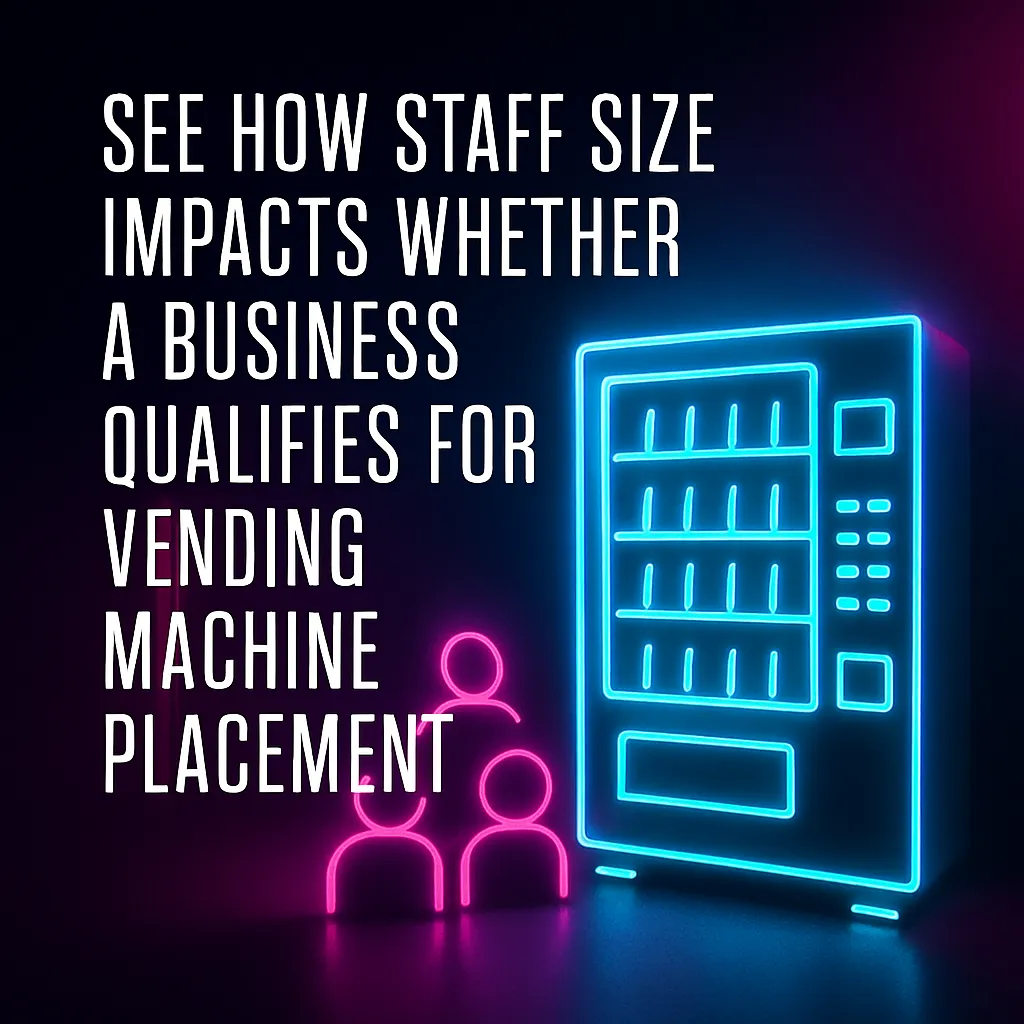What Is the Minimum Number of Employees Needed for Vending?
See how staff size impacts whether a business qualifies for vending machine placement.
Back to Vending FAQs ResourcesSee how staff size impacts whether a business qualifies for vending machine placement.
Back to Vending FAQs ResourcesWhile there's no strict rule, most vending providers look for a consistent group of potential users to ensure profitability, often around 25-50 employees for optimal placement.
![]() Employee count often dictates machine type and service level
Employee count often dictates machine type and service level
![]() Consistent daily foot traffic is more important than total headcount
Consistent daily foot traffic is more important than total headcount
![]() Smaller teams might qualify for micro-markets or specialized units
Smaller teams might qualify for micro-markets or specialized units

For businesses considering adding vending machines, one of the most common questions revolves around the minimum number of employees required. While there isn't a hard and fast rule universally applied, the employee count, alongside other critical factors, significantly influences a vending company's decision to place machines at a location. Understanding these dynamics can help businesses assess their readiness for vending services.
Vending machine operators are looking for viable locations that promise consistent sales volume. The number of employees directly correlates with the potential daily usage of the machines. Generally, a location with a higher, stable employee base translates to more frequent purchases, making the venture more profitable for the vending provider. Most providers consider a baseline of around 25-50 employees as a good starting point for a traditional vending machine setup. This ensures enough daily traffic to justify the cost of equipment, stocking, and maintenance.
While employee numbers are important, they are not the sole determinant. Vending companies also evaluate:
If your business falls below the typical employee threshold, don't be discouraged. Many providers are flexible and look at the overall potential. Micro-markets, for example, are gaining popularity in offices with 75+ employees, offering a self-checkout cafeteria-style experience. For smaller groups, a single high-quality combo machine might be perfect. The key is to communicate your specific needs and the unique characteristics of your workplace to a vending specialist.
Ultimately, the "minimum" is less about a fixed number and more about creating a sustainable, mutually beneficial relationship for both the business and the vending service provider. By understanding these factors, you can better position your business to acquire the vending solutions that best meet your team's needs.
While there's no universal strict minimum, most vending providers look for locations with consistent foot traffic and a reasonable number of potential users, typically starting around 25-50 employees for a traditional setup.
Employee count is a key factor as it directly correlates with potential sales volume. A higher number of employees generally means more customers, making the location more profitable for the vending operator.
Yes, it's possible. For smaller offices, newer technologies like AI vending coolers or micro-markets might be more suitable, or a vending operator might consider the overall foot traffic if it's a public-facing business.
Beyond employee count, factors like specific business type, customer traffic, operating hours, available space, current employee amenities, and even proximity to other food options play a significant role.
Typically, yes. Full-service vending, where the provider handles all stocking and maintenance, usually requires a higher projected sales volume to justify the operational costs, hence a larger employee base often helps.
Yes, generally. Traditional snack and drink machines might require 50+, while specialized coffee or healthy options might be placed in locations with 30-50 employees, and micro-markets often suit 75+.
With hybrid and remote work models, the peak daily number of employees present on-site becomes more relevant than the total employee count. Consistent daily presence is key for vending viability.
Absolutely. For businesses open to the public, the combined total of customer and employee traffic often surpasses the need for a high employee count alone, making it an attractive location.
No maximum. Larger facilities with hundreds or thousands of employees can greatly benefit from vending, often requiring multiple machines or even micro-markets to serve everyone efficiently.
Vending agreements are often flexible. If your employee count significantly increases or decreases, it's best to communicate with your vending provider to adjust services or product offerings accordingly.